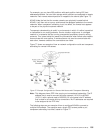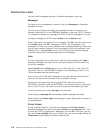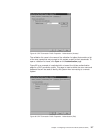You can connect to DDS using a special box called Channel Service Unit/Data
Service Unit (CSU/DSU), which replaces the modem in the analog scenario. DDS
has physical limitations that are primarily related to the distance between the
CSU/DSU and the Telephone Company Central Office. DDS works best when
distance is less than 30,000 feet. Telephone companies can accommodate longer
distances with signal extenders, but this service comes at higher cost. DDS is best
suited for connecting two sites that are served by the same Central Office. For long
distance connections that span different Central Offices, mileage charges can
quickly add up to make DDS impractical. In such cases, Switched-56 may be better
solution.
Typically, you can connect to a DDS CSU/DSU over V.35, RS449, or X.21 serial
interface with synchronous protocol at rates up to 56Kbps.
Switched-56
When you do not need a full-time connection, you can save money by using
switched digital service, which is generally called Switch-56 (SW56). An SW56 link
is similar to DDS setup in that the DTE connects to the digital service by way of
CSU/DSU. An SW56 CSU/DSU, however, includes a dialing pad from which you
enter the phone number of the remote host.
SW56 lets you make dial-up digital connections to any other SW56 subscriber
anywhere in the country or across international borders. An SW56 call is carried
over the long distance digital network just like a digitized voice call. SW56 uses the
same phone numbers as the local telephone system, and usage charges are the
same as those for business voice calls.
SW56 is available only in North American networks, and it is limited to single
channels that can only carry data. SW56 is an alternative for locations where ISDN
is unavailable.
Typically, you can connect to a SW56 CSU/DSU over V.35 or RS 449 serial
interface with synchronous protocol at rates up to 56Kbps. With a V.25bis
call/answer unit, data and call control flow over a single serial interface.
ISDN
Like Switched-56, ISDN also provides switched end-to-end digital connectivity.
Unlike other services, however, ISDN can carry both voice and data over the same
connection.
There are different types of ISDN services, with Basic Rate Interface (BRI) being
the most common. BRI consists of two 64Kbps B channels to carry customer data
and a D channel to carry signaling data. The two B channels can be linked together
to give a combined rate of 128Kbps. In some areas, the phone company may limit
each B channel to either 56Kbps or 112Kbps combined.
There is also a physical constraint in that the customer location must be within
18,000 feet of the central office switch. This distance can be extended with
repeaters.
You can connect to ISDN with a device called a terminal adapter. Most terminal
adapters have an integrated network termination unit (NT1) that allows direct
connection into a telephone jack. Typically, terminal adapters connect to your
Chapter 4. Configuring Point-to-Point TCP/IP (PPP and SLIP) 113


















